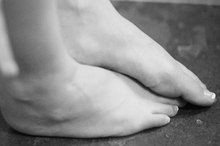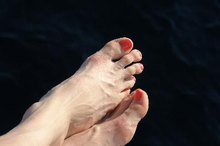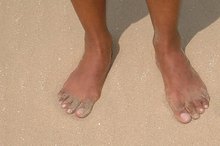What Causes Foot Pain on the Sole?
The soles of our feet must withstand all the pressure placed upon them during our lifetime by walking, running and standing. According to Foot Pain Info, there are 26 bones and associated ligaments in the foot, structured to allow the foot to function as a shock absorber and a lever 1. Foot pain can affect any part of the foot 3. Pain on the sole of the foot can be felt under the heel, in the middle of the foot under the arch and under the ball of the foot due to a variety of conditions 3.
If you are experiencing serious medical symptoms, seek emergency treatment immediately.
Plantar Fasciitis and Heels Spurs
The plantar fascia is a thick, broad ligament that runs along the bottom of the foot from the heel to the base of the toes. This fascia maintains the structure of the arch. According to MedlinePlus, the plantar fascia can become inflamed from injury or overuse, causing a dull ache on the sole of the foot 2. A heel spur can form on the heel bone, or calcaneus, where the plantar fascia attaches, causing pain along the sole. Conditions that predispose you to plantar fasciitis or formation of a heel spur include obesity, long-distance running and a rigid flat or high-arched foot 2.
Metatarsalgia and Arthritis
Causes of Chronic Ankle & Foot Pain
Learn More
Metatarsalgia refers to pain felt under the ball of the foot 3. According to the Merck Manuals, it can be the result of nerve injury, poor circulation or a joint abnormality such as arthritis. The nerves may become irritated from repetitive stress or from the formation of Morton's neuroma, a benign nerve tumor. Nerve injury produces a burning pain in the toes and ball of the foot, followed by loss of sensation 3. Arthritis can affect any joints in the foot, causing a dull achy pain that is worse upon rising and improves throughout the day.
Fracture and Stress Fracture
A break in the bone is termed a fracture. Fractures can result from direct or indirect trauma. A stress fracture can occur from a repeated and forceful stress, such as running or jumping, according to MayoClinic.com 4. A fracture causes a sudden onset of sharp pain on the sole of the foot, while stress fracture pain first appears as a barely noticeable ache that becomes debilitating over time.
- A break in the bone is termed a fracture.
- A stress fracture can occur from a repeated and forceful stress, such as running or jumping, according to MayoClinic.com 4.
Tarsal Tunnel Syndrome
Have Heel Spurs? How to Strap Your Foot
Learn More
The posterior tibial nerve travels through a narrow tunnel of ligament and bone alongside the ankle as it passes from the leg into the foot. According to Foot Health Facts, it is possible for this nerve to become compressed and irritated, producing tingling pain along the sole of the foot. Those with diabetes, arthritis and extremely flat feet are more likely to develop tarsal tunnel syndrome 5.
Plantar Warts, Corns and Callouses
Plantar warts, caused by human papillomavirus, are flat warts that grow on the bottom of the foot. The virus can enter through small breaks in the skin, such as cuts. When plantar warts form over pressure points on the sole, they may cause a sharp pain. Corns and callouses are patches of thickened skin that form under pressure points on the sole to protect those areas from friction. Corns and callouses may also cause a sharp pain, particularly when walking.
- Plantar warts, caused by human papillomavirus, are flat warts that grow on the bottom of the foot.
- When plantar warts form over pressure points on the sole, they may cause a sharp pain.
Related Articles
References
- MedlinePlus: Plantar Fasciitis
- Merck Manuals: Pain in the Ball of the Foot (Metatarsalgia)
- MayoClinic.com: Stress Fractures
- Foot Health Facts: Tarsal Tunnel Syndrome
- Mueller S, Carlsohn A, Mueller J, Baur H, Mayer F. Influence of obesity on foot loading characteristics in gait for children aged 1 to 12 years. PLoS ONE. 2016;11(2):e0149924. doi:10.1371/journal.pone.0149924
- American Academy of Orthopaedic Surgeons, OrthoInfo. Plantar fasciitis and bone spurs.
- Lim AT, How CH, Tan B. Management of plantar fasciitis in the outpatient setting. Singapore Med J. 2016;57(4):168-70. doi:10.11622/smedj.2016069
- Ross MH, Smith MD, Mellor R, Vicenzino B. Exercise for posterior tibial tendon dysfunction: a systematic review of randomised clinical trials and clinical guidelines. BMJ Open Sport Exerc Med. 2018;4(1):e000430. doi:10.1136/ bmjsem-2018-000430
- American Academy of Orthopaedic Surgeons, OrthoInfo. Turf toe. Reviewed June, 2019.
- National Library of Medicine, MedlinePlus. Tarsal tunnel syndrome. Reviewed March 11, 2019.
- Cleveland Clinic. Heal pain: common causes, symptoms, and treatments. Reviewed December 13, 2017.
Resources
Writer Bio
Kathryn Meininger began writing and publishing poetry in 1967. She was co-founder and editor of the professional magazine "Footsteps" and began writing articles online in 2010. She earned a Doctor of Podiatric Medicine from Temple University School of Podiatric Medicine and a Bachelor of Arts in biology from William Paterson University.







